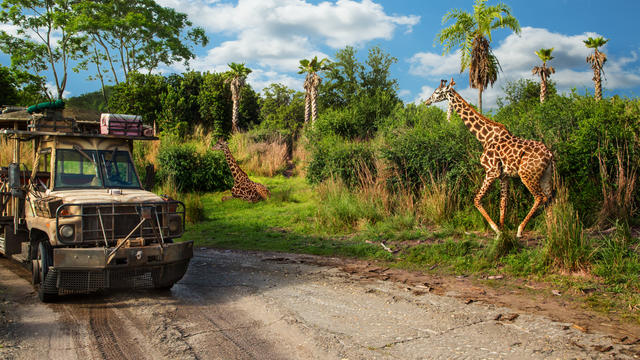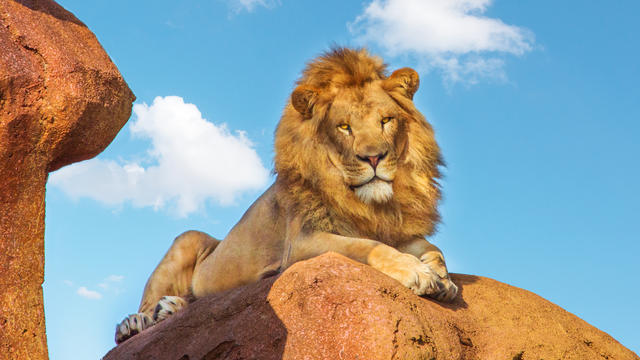Kilimanjaro Safaris is one of our all time favourite attractions at Walt Disney World. We love it so much we rated it 5/5 in our Animal Kingdom attractions guide. With that in mind, here are 9 awesome facts about one of Disney’ most beloved and ambitious rides.
#1 Walt Disney Inspired Kilimanjaro Safaris
While it might seem incredibly unlikely, Walt Disney himself actually played a part in the creation of Kilimanjaro Safaris.
The first plans for the Jungle Cruise actually included real animals but it was quickly discovered that they would be far too unpredictable for the kind of attraction Disney wanted to deliver to park guests.
Fast forward to when Disney’s Imagineers were planning Animal Kingdom and Walt’s original dream became a reality.
#2 That’s One Big Attraction
Kilimanjaro Safaris is the biggest Disney park attraction in the world. Don’t believe us? You could fit the entire Magic Kingdom park in Kilimanjaro Safaris quite comfortably!
Kilimanjaro Safaris is 110 acres whereas the entire Magic Kingdom park comes in at 107 acres. Disney were not messing about with animal welfare when it came to designing this attraction.
The attraction itself makes up 20% of the entire Animal Kingdom park.
#3 The Lion Feels the Breeze Tonight
Though they aren’t always completely visible, the Lions in Kilimanjaro Safaris would be even less visible if it wasn’t for a bit of clever engineering from Disney.
The rocks in which the Lions hang around on for much of the day are actually air conditioned! The Lions originally came from a much cooler zoo in Oregon so Disney had to install air-con into the rock formation. Better yet, if it gets cold they can heat up so the lions can be comfortable all year round!
#4 Every Animal Needs to Rest
At the end of every day, animals throughout the attraction are called in to rest in their enclosures for the night. Each animal has been specially trained to respond to a different sound.
A few examples of this include crocodiles responding to a metal bar being hit underwater, elephants come in to the beat of a drum, giraffes for a cowbell and a duck call is used for the Thompson’s Gazelle.
#5 Free Roaming Animals
While every animal has set space to walk around in (you wouldn’t want the Lions in with the gazelles!), within their space they are free to walk wherever they wish.
That means that they have right of way, even to the Safari trucks that form part of the attraction. If an animal chooses to walk in front of a truck (has happened to us many times) then be thankful as it means you will be able to get up close with those cameras!
Spaces are controlled through a combination of chains in the ground (to stop animals crossing into another area), walls and even deep pits in the case of the lions.
#6 Fake Plastic Baobab Trees
Okay, not plastic but we wanted to sneak in a Radiohead reference… The famous Baobab trees that are scattered around Kilimanjaro Safaris are actually all fake and made of concrete. The real tree has a thick trunk and is very good at storing water during periods of drought.
There was a single real Baobab tree in Disney’s Animal Kingdom in Harambe Village but sadly it died during a cold winter a few years ago.
#7 Animals Are Kept Close to Park Guests
Though it would be almost impossible to see on the first few experiences of Kilimanjaro Safaris, Disney actually does a lot to make sure the animals wander as close to guests as possible.
In addition to the air-conditioned rocks we already covered, Disney tactically place hay, grass, salt licks and drinking water close to the roads in which the safari trucks travel. Some of these placements are obvious when you know to keep an eye out but others are really well hidden, how many can you spot on your next safari?
#8 Real Safari Trucks
A lot of guests simply assume that the cast members aboard the great big safari trucks are simply onboard for guest safety and that the attraction is all on a track. This is completely false.
Cast Members go through rigorous training to land the role on Kilimanjaro Safaris and all of the custom built GMC and Ford trucks are free roaming. It is essential that this is the case as on many occasions cast members have had to swerve off course to go round an animal that has decided to settle on the road.
Each night the safari trucks are driven off the road and into a lot where they can be assessed and serviced ready for the next day.
#9 Timing is Everything
Though it is fair to say animals can be seen no matter what time of day Kilimanjaro Safaris is ridden, there are times of day where the animals are most active.
Early in the mornings, just after Disney’s Animal Kingdom has opened, can be a great time to experience the safari due to the cooler temperatures. In addition to this, the animals are all grazing on their breakfasts!
Disney introduced nighttime safaris in 2016 and this also offers a great time to see some of the animals who prefer to be active during the evening. These include Warthog, Hippo, Hyena and African Wild Dog.
Of course every safari is different and we can never guarantee that you will see great views of the animals on every trip.
Want more on Disney’s Animal Kingdom? Be sure to check out the rest of our Animal Kingdom guides.




